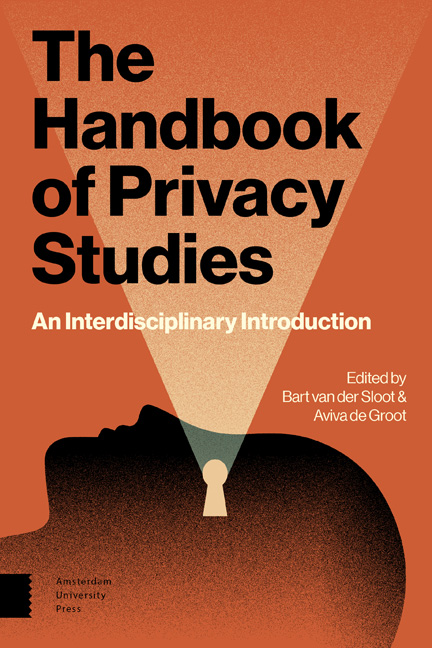Book contents
- Frontmatter
- Contents
- Introduction
- 1 Privacy from a Historical Perspective
- Legislating Privacy: Technology, Social Values, and Public Policy
- 2 Privacy from a Legal Perspective
- Three Dimensions of Privacy
- 3 Privacy from an Ethical Perspective
- Nudging: A Very Short Guide
- 4 Privacy from an Economic Perspective
- Security, Privacy, and the Internet of Things (IoT)
- 5 Privacy from an Informatics Perspective
- Political Science and Privacy
- 6 Privacy from an Intelligence Perspective
- A Privacy Doctrine for the Cyber Age
- 7 Privacy from an Archival Perspective
- Medical Privacy: Where Deontology and Consequentialism Meet
- 8 Privacy from a Medical Perspective
- Privacy Law – on the Books and on the Ground
- 9 Privacy from a Media Studies Perspective
- Diversity and Accountability in Data-Rich Markets
- 10 Privacy from a Communication Science Perspective
- Still Uneasy: a Life with Privacy
- 11 Privacy from an Anthropological Perspective
- About the Authors
Three Dimensions of Privacy
- Frontmatter
- Contents
- Introduction
- 1 Privacy from a Historical Perspective
- Legislating Privacy: Technology, Social Values, and Public Policy
- 2 Privacy from a Legal Perspective
- Three Dimensions of Privacy
- 3 Privacy from an Ethical Perspective
- Nudging: A Very Short Guide
- 4 Privacy from an Economic Perspective
- Security, Privacy, and the Internet of Things (IoT)
- 5 Privacy from an Informatics Perspective
- Political Science and Privacy
- 6 Privacy from an Intelligence Perspective
- A Privacy Doctrine for the Cyber Age
- 7 Privacy from an Archival Perspective
- Medical Privacy: Where Deontology and Consequentialism Meet
- 8 Privacy from a Medical Perspective
- Privacy Law – on the Books and on the Ground
- 9 Privacy from a Media Studies Perspective
- Diversity and Accountability in Data-Rich Markets
- 10 Privacy from a Communication Science Perspective
- Still Uneasy: a Life with Privacy
- 11 Privacy from an Anthropological Perspective
- About the Authors
Summary
In what follows, I want to look at a systematic account of privacy in which I differentiate, explain, and discuss three dimensions of privacy. Conceptions of privacy based upon a concept of autonomy or individual freedom provide the most interesting and forward-looking possibilities for a conceptualization of the term. Three such dimensions of privacy should be distinguished. These dimensions – not realms, not spaces – of privacy serve to protect, facilitate, and effectuate individual liberties in a variety of respects. Freedom-oriented theories of privacy are to be found within the whole range of theories of privacy, from those that deal with the privacy of (intimate) actions to those concerned with informational privacy or the privacy of the household. It makes sense, therefore, to discuss these different aspects of freedom and privacy individually.
Decisional privacy
It is only in recent years that decisional privacy, or the privacy of actions, has been a specialist term in the literature. A decisive factor here was the ruling of the US Supreme Court in the Roe v. Wade case, where for the first time in US legal history women were granted a right to physical, sexual self-determination and to terminate a pregnancy, this being grounded upon an appeal to a right to privacy. As the explanation formulated by Justice Blackmun famously put it, ‘this right to privacy (…) is broad enough to encompass a woman's decision whether or not to terminate her pregnancy’ (Roe v. Wade, 410 US 113 [1973] 153). This verdict and the discussions that preceded and followed it were hugely influential upon the conceptualization of privacy not only in the United States. As a result, feminist theory has treated sexual freedom of action, the privacy of intimate and sexual acts, and the woman's right of sexual self-determination as central elements in the theory of privacy. Decisive significance is given to the privacy of the body (Gatens 2004). This includes the woman's newly won right to conceive of her body as private to the extent that she can decide for herself whether or not to bear a child, and thus enjoys rights of reproductive freedom.
The idea of physical privacy in the sense of the privacy of actions that concern the intimate sphere of women and men lies at the heart of decisional privacy.
- Type
- Chapter
- Information
- The Handbook of Privacy StudiesAn Interdisciplinary Introduction, pp. 137 - 142Publisher: Amsterdam University PressPrint publication year: 2018



